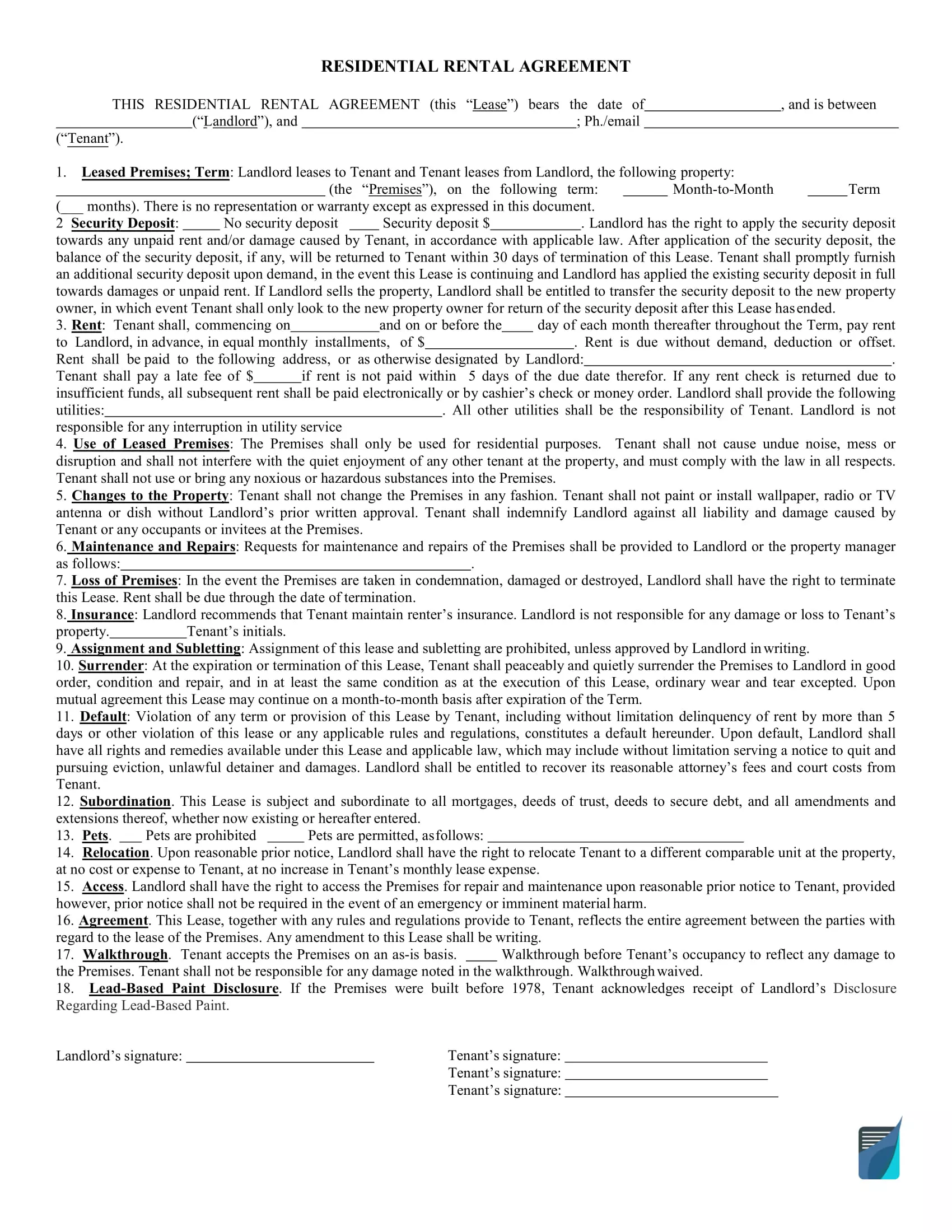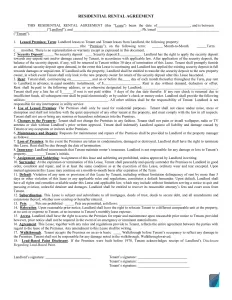Simple One-page Rental Agreement
A simple rental agreement is as legal as any other contract. While a longer agreement may seem to abide by the laws of the state, a rental lease form functions in the same way minus the fluff. In a standard lease, all key aspects are covered. Among these are the rent term or duration, monthly rent amount, security deposit, information about the premises, terms of use, and obligations when it comes to maintenance or utilities. FormsPal’s short-form lease agreement covers all of these basics.

Build Your Document
Answer a few simple questions to make your document in minutes
Save and Print
Save progress and finish on any device, download and print anytime
Sign and Use
Your valid, lawyer-approved document is ready
Why Use a One-Page Lease Agreement Template?
A free rental agreement form may come in different versions. Some may cover more details and terms while others keep to the standard provisions to create a simple rental document. To check if this is the right document for you, here are some pros and cons:
PROS:
- The straightforward language in the short lease contract can be easily understood by the landlord and tenant;
- The essential aspects are still explained thoroughly. This includes a security deposit, period of time, and delegation of responsibility between landlord and tenant.
- If the landlord and tenant agree to renew this rental agreement every month, less time will be needed to check, ensuring a smooth transaction.
- Riders can still be attached to this type of residential lease agreement.
- The landlord has the upper hand in the basic rental agreement since his or her permission must be obtained in some provisions.
- For the tenant, this type of residential lease agreement has fewer restrictions.
CONS:
- On the downside, a shorter lease agreement does not provide the landlord an opportunity to discuss common areas of the real estate, which may be troublesome for someone renting a shared building. Fortunately, the landlord may seamlessly add this through a lease agreement builder.
- Because the rental agreement is short, it does not discuss important legal wording in detail. Some of these are:
- “Indemnify”– This word explains that the landlord will not be responsible for any damage or harm that happens inside the premises. This is acceptable if there is no common area on the premises. However, if there are, you may want to include a more specific discussion about the landlord’s responsibilities for these shared spaces.
- “Reasonable prior notice” – Since the word “reasonable” is quite subjective, you may check real estate laws of the state. In most states, a 30-day notice is required. The length of notice is also determined by the circumstance.
- “Any rules and regulations” – These normally come as attachments or riders to the rental lease agreement.
- A fixed-term rental requires more opportunities to discuss alterations, maintenance, property use, and other conditions that are crucial to keeping both parties at peace in the long-term. A short rental agreement may not provide this.
- This type of rental agreement does not discuss the number of “occupants” or “use of furnishings,” although additional conditions or lists of occupants may be included as a rider to the contract.
Get a Personalized Document
FormsPal provides a free lease agreement template, which can be readily downloaded and used. You may choose from an MSWord file (DOCX), PDF, or an Open Office program (ODT).
To further customize your lease agreement in order to match your real estate rental needs, you may use FormsPal’s step-by-step builder.
Why customize your own rental agreement?
The landlord and the tenant may want to add more conditions for the following reasons:
- Having a personalized rental agreement gives more security to both parties.
- It makes the agreement more thorough and therefore reduces the need to negotiate.
- Through the contract builder, the landlord may add other important information and provisions.
- The tenant’s needs and requests can be accommodated through the builder.
- The builder can ensure that additional clauses and amendments are kept legal.
Simple One-page Rental Agreement Form Details
| Document Name | Simple One-page Rental Agreement Form |
| Other Name | Basic Rental Agreement |
| Avg. Time to Fill Out | 8 minutes |
| # of Fillable Fields | 27 |
| Available Formats | Adobe PDF |

Filling Out the Basic Agreement
Step 1— Download the one-page lease agreement.
FormsPal has prepared a free printable basic rental agreement, which you can download on this page.
If you don’t have any of the required programs to open the above rental agreements, we highly suggest that you install the free Open Office program.
Step 2— Identify the parties involved.
A “party” is someone who partakes in the agreement. In this case, those involved are the “landlord” or “lessor” who owns the real estate property and the “tenant” or “lessee” who will be paying for the right to occupy that space for a determined “term” or duration.

The following will be needed in the opening paragraph of the agreement:
- Blank 1: Date of the agreement
- Blank 2: Full name of the landlord
- Blank 3: Full name of the tenant
- Blank 4: Phone number and e-mail address of the tenant.
Step 3— Describe the nature of the lease.
A lease must also answer the questions “Where?” and “How long?” Below is the information to be included in section one:

- Blank 1: Complete address of the real estate property (include its unit number, floor, building number, street, area, city, county, state, zip code).
- Box 2: You may either tick “Month-to-month” (2.1) if the contract should be renewed by both parties on a monthly basis, or tick “Term” (2.2) to encompass a longer duration without the need to renew after each month.
- Blank 3: If you ticked box 2.2, then type the number of months wherein the tenant may occupy the premises. The end date is automatically the last day of this duration.
Step 4— Determine the security deposit.
In most cases, a security deposit is required for new tenants, even after a thorough background check. This is necessary to secure payments for utilities or to repair damages just in case the tenant leaves without settling his or her obligations.

- Box 1: Choose whether the tenant does not need to give a security deposit (box 1.1). If the landlord requires a security deposit, then he or she must tick the second box (1.2)
- Blank 2: If Box 1.2 is applicable, write the amount of deposit on the line provided. Attorneys recommend payment of no more than 150% of the monthly rent amount.
Step 5— Clarify the rent amount and conditions.
Unlike a longer lease agreement, short contracts combine the rent details and conditions in one paragraph and are filled out as follows:

- Blank 1: Type the date when the rental term begins.
- Blank 2: In ordinal format, type the due date of the monthly rent is due (e.g. “3rd day of each month”)
- Blank 3: Input the numerical amount of the month’s rent in dollars.
- Blank 4: The full address designated by the Landlord where the tenant must pay rent. This could be his or her residential address, office, or a representative’s address.
- Blank 5: Write the amount of penalty in dollars (separate from rent).
- Blank 6: Include which utilities the landlord will be paying on behalf of the tenant. These will be considered “inclusive” of the rent payment and will not be added. If this is not applicable, simply write “n/a” (not applicable).
Step 6— Review the terms and conditions for the lease.
In sections four to seven, both tenant and landlord must review how the premises will be used.

In section six, in particular, the landlord must indicate the manner in which he or she wishes to receive requests. Depending on the urgency, the problem may also be remedied by the tenant without notice to the other party. However, this section does not provide provisions for reimbursement.
To make changes to these sections, we at FormsPal highly recommend consulting an attorney or using our custom lease agreement builder.
Step 7— Discuss what happens when damages occur.
Even with proper attention and due diligence, major unpredictable problems can still occur. This includes fires, burglary, or acts of nature. When this happens, sections seven and eight apply.

- Blank 1, the tenant must agree to this waiver by placing his or her signature or handwritten initials on the blank provided.
Step 8— Read the standard clauses.
Sections nine to twelve are standard in any lease agreement, but it is important to still discuss these with the other party.

Step 9— Discuss conditions for keeping pets on the premises.
Though not all tenants may have pets, those who own “fur babies” will take this clause as a make-or-break decision point. Therefore, the agreement must contain a clause about pet ownership. If you are the landlord, you may use the following options:

- Box 1: Tick 1.1. if you simply cannot allow pets on the premises or if the tenant has no plans of keeping them. Otherwise, tick 1.2 to allow pets.
- Blank 2: Write your conditions for the pets. You may want to indicate a certain size limit, breed, or type of animal.
Step 10— Check other standard additional provisions
In rare cases, landlords may need to relocate tenants and enter the premises. Sections 14 and 15 discuss these. On the other hand, section 16 mentions other “rules and regulations” that may be attached as riders to the lease agreement.

Step 11— Give the tenant a walkthrough.
It is standard for both landlord and tenant to check the condition of the premises before it is leased. During the walkthrough, both parties may take pictures to document.

- Box 1: If the walkthrough is accomplished and the tenant agrees to the present condition of the real estate property or space, the landlord may tick box 1.1, Otherwise, simply tick 1.2 if the tenant trusts the landlord’s word and signs the lease without a thorough walkthrough.
Step 12— Disclose any health hazards.
The agreement must disclose the presence of harmful materials on the premises. Lead-based paint disclosures are the most common warnings for residential properties. However, other disclosures can be added if there is a presence of mold or bed bugs.

Step 13— Sign the lease agreement.
If the landlord and the tenants agree on all the provisions of the rental agreement, they can sign on the blank provided along with their printed name. Those living with the main tenant may also add their signatures on the blanks provided on the second and third lines.

A one-pager rental lease agreement can simplify paper works and make the rental process more efficient, benefiting both parties. However, it does have its pros and cons. We at FormsPal highly recommend checking if this concise lease contract works for you. If you find that some adjustments still need to be made, you may consult an attorney or use our contract builder.
